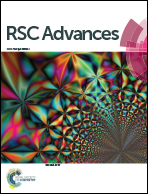Promoting visible light-driven hydrogen evolution over CdS nanorods using earth-abundant CoP as a cocatalyst†
Abstract
Exploiting earth-abundant cocatalysts for photocatalytic hydrogen evolution is of great interest. Herein, earth-abundant CoP was used as a cocatalyst to fabricate a CdS nanorod based photocatalytic system. Meanwhile, visible light-driven H2 evolution over the CoP decorated CdS nanorods was investigated. Moreover, the electrochemical behavior and photoelectrochemical behavior of the CdS/CoP photocatalytic system were explored to deeply demonstrate the essential role that CoP played in the photocatalytic process. Lastly, the photocatalytic mechanism was preliminarily discussed. The results indicated that the photocatalytic activity of the CdS nanorods could be remarkably enhanced due to the introduction of CoP. Under optimal conditions, a rate of H2 evolution of approximately 2.12 mmol h−1 was achieved and the apparent quantum yield was up to 27.1% at 435 nm, which was about 20 times higher than that over the CdS nanorods and 1.5 times higher than that over the Pt loaded CdS nanorods, respectively. This dramatic photocatalytic activity of the CoP modified CdS nanorods may be ascribed to the low H+ reduction overpotential on the CoP particles and the efficient electron transfer between CdS and CoP. The present work demonstrates that CoP is a promising alternative to Pt as an efficient cocatalyst for CdS.


 Please wait while we load your content...
Please wait while we load your content...